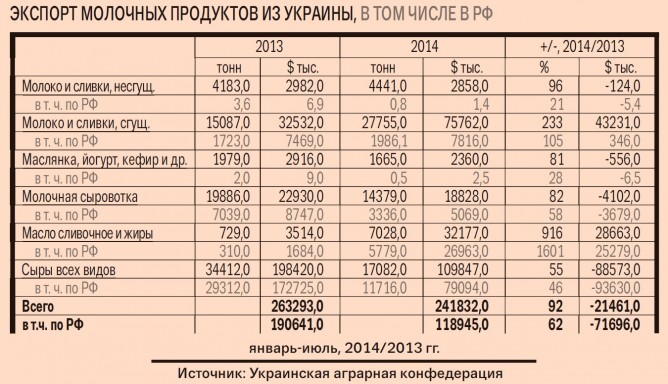Business
collapseUkrainian cheese makers dramatically reduced exports thanks to Russia

In August, Ukrainian cheese exporters set a new record low of production over the years of the country’s independence – 340 t of the products were exported from Ukraine for US $2.1 mn over the specified period. This is 13.2 less than in August 2013. Over eight months of the year, foreign supplies dropped by half and in monetary terms amounted to around US $112 mn.
The reason for the decline in supplies of cheese is well-known – namely, the ban on supplies of dairy Ukrainian products to Russia and Crimea, which took force on July 28. A month later, on August 22, RosSelkhoznadzor (Federal Service for Veterinary and Phytosanitary Monitoring of Russia) allowed Ukrainian companies to supply their products to the Crimean peninsula. However, this did not substantially change the situation. “Crimea accounts for only 5% of the total consumption,” explains CEO of the Union of Dairy Companies of Ukraine Vadym Chaharovskiy.
Production on the decline
The decrease in export led to the reduction of the production volumes of cheese. The State Statistics Service reported that in January-August 2014 Ukraine produced 85,200 t of cheese, which is 23% less than in the same period last year. “This is not surprising as cheese exports have become miserly, while domestic consumption is not increasing,” explains Director of the InfAgro Analytical Agency Vasyl Vyntonyak. Unlike in the previous year, producers are not risking to produce cheese products and stockpile them in warehouses, he adds. “As the minimum stocks are being sold, the plants are resuming operation and then their operation is suspended again in a manual regime,” he explains.
Due to the sharp decrease in exports to Russia, the supply of cheese products on the Ukrainian market increased, says expert of agrarian markets at the Ukrainian Club of Agrarian Business Alina Zharko. Producers, however, are not in a hurry to lower their prices. “The plants sell traditional products to distributors in the price range of UAH 56,000-60,000 per ton, and to retail chains – UAH 68,000-73,000 per ton,” notes Vyntonyak. Producers fear that prices on the domestic market will simply collapse.
Meanwhile, the companies are more cooperative with exporters and are ready to provide up to a 10% discount on prices. “Cheese is offered at US $5,000-5,700 per ton to post-Soviet countries,” says Vyntonyak.
Promising markets
There is a possibility to minimize losses from the Russian blockade. For this dairy companies must increase production of butter and powder milk, which will open new markets for them, believes Zharko. She says that butter can be supplied to Moldova, Armenia and Azerbaijan, as well as to practically undeveloped Asian markets. Supplies of powder milk are more promising from the vantage point of logistics, as it is easier to supply it to faraway countries thanks to their long shelf life.
“Producers may be interested in the markets of CIS, Asian and African countries, such as Algeria and Egypt,” said Zharko. There are free niches in those countries that Ukrainian producers of dairy products can take advantage of.
Dairy producers are already taking such a step. Head of the Investor Relations Service at the Milkiland Group of Companies Serhiy Trifonov says the company is diversifying supplies and changing its assortment. The company reduced production of cheese products and increased production of powder milk. “At the moment, we are actively supplying our products to CIS countries, in particular to Kazakhstan. We are very interested in markets in North Africa and the Middle East,” says Trifonov. He adds that the company plans to organize distribution in Kazakhstan and countries in Central Asia.







 of the agreement of syndication with Financial Times Limited are strictly prohibited. Use of materials which refers to France-Presse, Reuters, Interfax-Ukraine, Ukrainian News, UNIAN agencies is strictly prohibited. Materials marked
of the agreement of syndication with Financial Times Limited are strictly prohibited. Use of materials which refers to France-Presse, Reuters, Interfax-Ukraine, Ukrainian News, UNIAN agencies is strictly prohibited. Materials marked  are published as advertisements.
are published as advertisements.